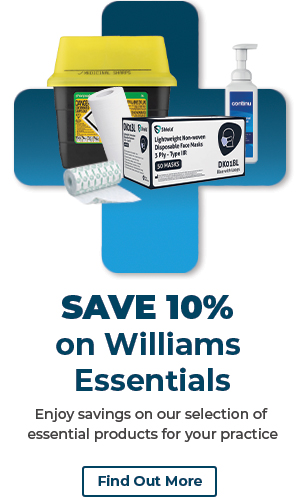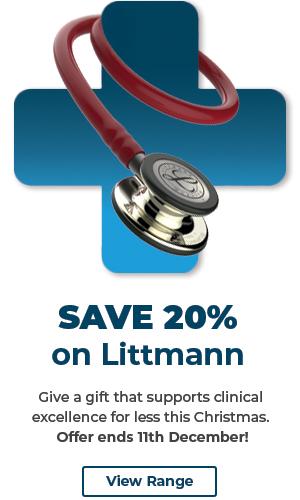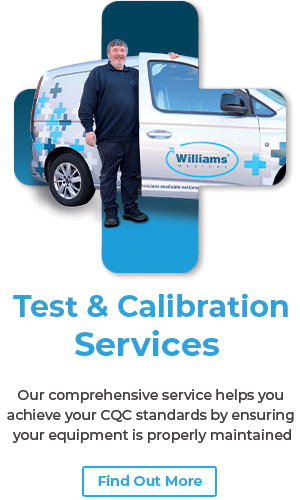AED Defibrillator: Why Immediate Access Saves Lives in Emergencies
01/11/2025
Every minute counts when someone suffers a cardiac arrest. Survival chances drop by up to 10% for every minute without an AED Defibrillator, yet fewer than one in ten people in the UK survive an out-of-hospital cardiac arrest. Automated External Defibrillators (AEDs) are simple, life-saving devices designed for anyone to use. But too often they are unavailable, unmapped, or underused. This article explains what an AED is, why it matters, the statistics you need to know, things to consider when choosing your defibrillator, and why Williams Medical Supplies is your trusted partner for AEDs.
Introduction
When someone goes into sudden cardiac arrest, every minute without CPR and defibrillation reduces their chance of survival by up to 10% (British Heart Foundation). Yet across the UK, fewer than one in ten people survive an out-of-hospital cardiac arrest. These numbers are a stark reminder that access to defibrillators saves lives.
Restart a Heart Day shines a light on the importance of CPR and defibrillator awareness. But the need doesn’t end when the campaign finishes. AEDs are vital all year round, in workplaces, schools, GP surgeries, and communities.
What is an AED Defibrillator & How It Works
An Automated External Defibrillator (AED) is a portable device designed to treat sudden cardiac arrest by delivering an electric shock that can restore a normal heart rhythm (St John Ambulance). Unlike the equipment used by hospital clinicians, AEDs are built for everyday rescuers to be simple, safe, and effective.
Here’s what typically happens when you use an AED:
1. Turn on the AED – the device provides voice instructions.
2. Attach the pads – place adhesive pads on the casualty’s chest as directed.
3. Allow rhythm analysis – the AED automatically assesses the heart’s rhythm.
4. Deliver shock if advised – the device either instructs you to press the button or delivers the shock automatically.
5. Continue CPR – follow the prompts until emergency services arrive.
AEDs are designed with built-in safeguards. They will only deliver a shock if one is needed, so you can act with confidence. Whether you’ve had training or not, the device guides you step by step, making it possible for anyone to save a life in an emergency (Mayo Clinic).
Key Statistics & Challenges
Every year in the UK, ambulance services attempt resuscitation in around 30,000 out-of-hospital cardiac arrests (Resuscitation Council UK). Survival rates remain low: fewer than one in ten people survive to hospital discharge (British Heart Foundation).
Some key statistics highlight both the urgency and the challenges:
• 70% of cardiac arrests see bystanders attempt CPR, but in fewer than 10% of cases is an AED used (St John Ambulance).
• Every minute without defibrillation reduces survival chances by up to 10% (Resuscitation Council UK).
• AEDs can double or triple survival rates when used promptly alongside CPR (SJA).
• There are estimated to be between 100,000 and 200,000 AEDs in the UK, but only about 30% are registered with ambulance services (Resuscitation Council UK).
• According to The Circuit, the national defibrillator network, many AEDs remain unmapped, meaning ambulance services can’t direct bystanders to them.
These figures show that the challenge is not just buying AEDs but ensuring they are accessible, registered, and trusted by the public.
Semi-Automatic Defibrillators
Cardiac support semi automatic defibrillators at Williams Medical Supplies
Why AED Defibrillators Matter in Workplaces and the Community
Sudden cardiac arrest can happen to anyone, anywhere. Around 80% occur in the home, but they also strike in workplaces, schools, sports centres, and public spaces (Resuscitation Council UK). That’s why AEDs need to be present across every setting, not just in hospitals.
A bystander performing CPR and using an AED can increase survival chances two- to four-fold (St John Ambulance). Combined with the fact that survival drops by up to 10% for every minute without defibrillation, it’s clear that having a device on hand makes the difference between life and death.
Yet access is not always straightforward. Some defibrillators are stored in locked cabinets, slowing response times unless bystanders call 999 for the code. Others are placed in areas of low footfall, or never registered on The Circuit.
AEDs are a vital safety net for workplaces and communities. Their presence, accessibility, and correct use give people a fighting chance in the critical first minutes of cardiac arrest.
Choosing an AED Defibrillator
Buying an AED can feel daunting, but understanding your options helps you make the right choice.
Buying considerations:
• Cost: AEDs typically range from £800 to £2,500, depending on features.
• Type: Choose between semi-automatic (requires button press) and fully automatic (delivers shock without input).
• Durability: Devices vary in water and dust resistance (IP ratings), which matters for outdoor or high-use environments.
• Features: Some models include CPR feedback, ECG displays, or LCD screens. Many perform daily, weekly, or monthly self-tests.
Maintenance:
• Pads and batteries must be replaced periodically, usually costing between £20 and £300.
• Manufacturers recommend routine checks to ensure the device is always ready.
Accessibility:
• Some ambulance trusts recommend unlocked or alarmed cabinets to avoid delays. If locked, ensure the access code is shared with ambulance services.
• Clear signage helps people recognise and use AEDs quickly.
Extras & accessories:
• Keep a kit alongside your AED: items like a towel, razor, scissors, spare pads, and a face shield make it easier to act fast.
Trusted brands such as Zoll, iPAD, and Philips offer reliable, user-friendly AEDs with proven track records. Choosing a model that fits your environment, whether a GP surgery, workplace, or community centre, ensures your investment is ready when needed most.
Fully Automatic Defibrillators
Life saving fully automatic defibrillators at Williams Medical Supplies
Special Use Cases & Limitations
AEDs are safe for almost everyone, but there are some important considerations. They can be used on children, pregnant women, and people with pacemakers. Many AEDs include paediatric pads, but if these aren’t available, adult pads can be used according to St John Ambulance guidance.
In rare cases, an AED may not be the most suitable solution. For high-risk patients with underlying heart disease, doctors may recommend an implantable cardioverter-defibrillator (ICD) instead (Mayo Clinic).
Cost and training can also be barriers for smaller organisations, but the simplicity of AEDs and their life-saving potential far outweigh these challenges.
AEDs are broadly safe and effective, but awareness of special use cases ensures they can be applied confidently in every situation.
Williams Medical Supplies: Your Trusted AED Defibrillator Partner
At Williams Medical Supplies, we believe that access to AEDs should be simple, reliable, and backed by trusted support. We’re not just a supplier. We’re here to help you create safer workplaces and communities.
We stock a wide range of AEDs, including trusted brands such as Zoll, iPAD, and Philips. Whether you need a semi-automatic or fully automatic model, our range covers environments from GP surgeries to schools and public venues.
With Williams Medical Supplies, you’re choosing more than a device. You’re choosing reliable support to keep your team prepared when it matters most.
FAQs
What’s the difference between a defibrillator and an AED?
“Defibrillator” is a general term for devices that deliver an electric shock to the heart. AEDs are portable, automated, and designed for use by laypeople in emergencies.
Can AEDs harm someone if misused?
No. AEDs are designed with built-in safeguards. They will only deliver a shock if one is needed, so you cannot harm someone by using one.
Can AEDs be used on children, pregnant women, or people with pacemakers?
Yes. AEDs are safe for use on children and adults. Paediatric pads should be used where available. They are also safe for pregnant women and those with pacemakers.
Do I need training to use an AED?
While training increases confidence, it isn’t essential. AEDs give clear voice instructions, making them usable by anyone in an emergency.
Conclusion
Every minute matters in cardiac arrest. Having a usable, accessible AED on-site can help save lives.
Don’t wait until an emergency exposes a gap in your readiness. Ensure your organisation is prepared today.
Williams Medical Supplies provides the tools and support you need to protect patients, staff, and your community, so you’re ready when every minute counts.
Disclaimer
This article is provided for general information and awareness only. It is not intended to replace professional medical advice, diagnosis, or training. Automated External Defibrillators (AEDs) should always be used in accordance with the manufacturer’s instructions and any relevant local or organisational protocols. For guidance specific to your workplace or clinical environment, please consult your healthcare provider, governing body, or resuscitation training organisation.


